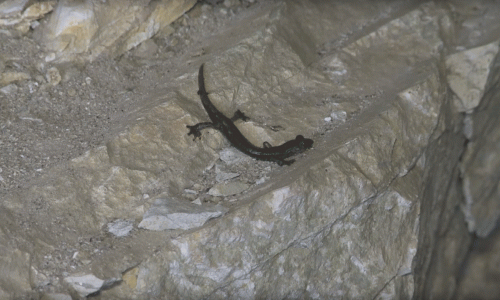
Geotriton
The newt is one of the few vertebrates in the world that has remained the same for millions of years. Its habitat, the cave, is the fixed ecosystem par excellence, allowing it to achieve excellent evolutionary adaptation. This little dragon is a surprising amphibian. It is the only
one that does not lay its eggs in the water, the only one that performs a sort of parental care, one of the very few that has no particular colors and that moves even in the middle of winter. The huge karst systems of Monte Nerone and Monte Catria host a population of geotritons of great importance in the national and international panorama. The cave-dwelling geotritons remain in the sector near the entrance and in the median sector if they are caves with a certain planimetric development. Seeing them, if they are active, is quite simple as their hunting trips, in which they try to catch insects and arachnids with their tongues, are made up of very slow movements and very long waits. We must have the utmost respect for this animal. The light must not be shined on it, no noise must be made and it must absolutely not be handled because its skin is so sensitive that contact with ours, much warmer than its, could cause small burns to the paws.
The cave means constant humidity but not necessarily water, so the female newt lays her eggs on the ground, protected from the risk of dehydration. This choice extends hatching times up to 9 months. In this long period of time, the newt takes a defensive attitude towards its eggs, staying close to them for a long time.
In areas where there are no karst phenomena, the newt lives in the woods, in the cavities of the root systems of the trees, with the decaying interior of the dead trees lying on the ground or with the small living space that is created under the pile of piled up trunks on the ground, it moves in the open with the help of darkness.
The newt (Speleomantes italicus) is an amphibian of the order of the urodeles, with a body length of 8-9 cm, rarely up to 12 cm, including the tail, and has relatively long legs, partially webbed, with short and stubby toes. Such features allow the newt to be an excellent climber, on rocks and beyond. The muzzle is square, the eyes large and protruding, the epidermis always moist which favors skin breathing, dark with evident whitish marbling in the lower part. The tongue is the weapon with which it hunts: it is particularly sticky and is everted when necessary.
The Italian species of the newt is a widespread endemism mainly along the Apennines from Emilia Romagna to Abruzzo.
The newt is strictly protected under the 1979 Berne Convention and is included in the list of species of community interest within the 1992 Habitat Directive (Annex D). Since 1997 it has also been included in the Red List of Italian vertebrates. In spite of these legislative measures, in the absence of an appropriate national or at least regional law for the protection of minor fauna, the damage that can be inflicted on a species like this and its habitats are most often verified when it is too late, without that is, that inalienable opportunity to prevent actions that are almost never recoverable.

